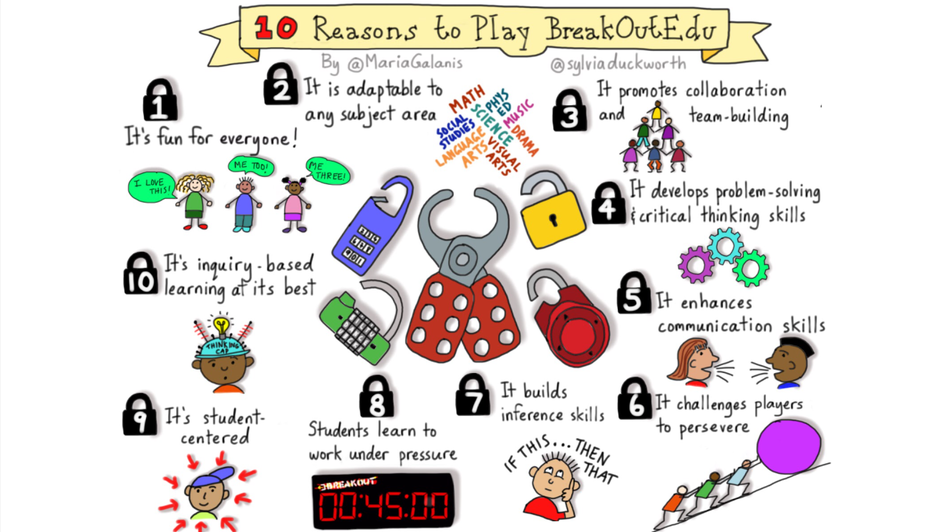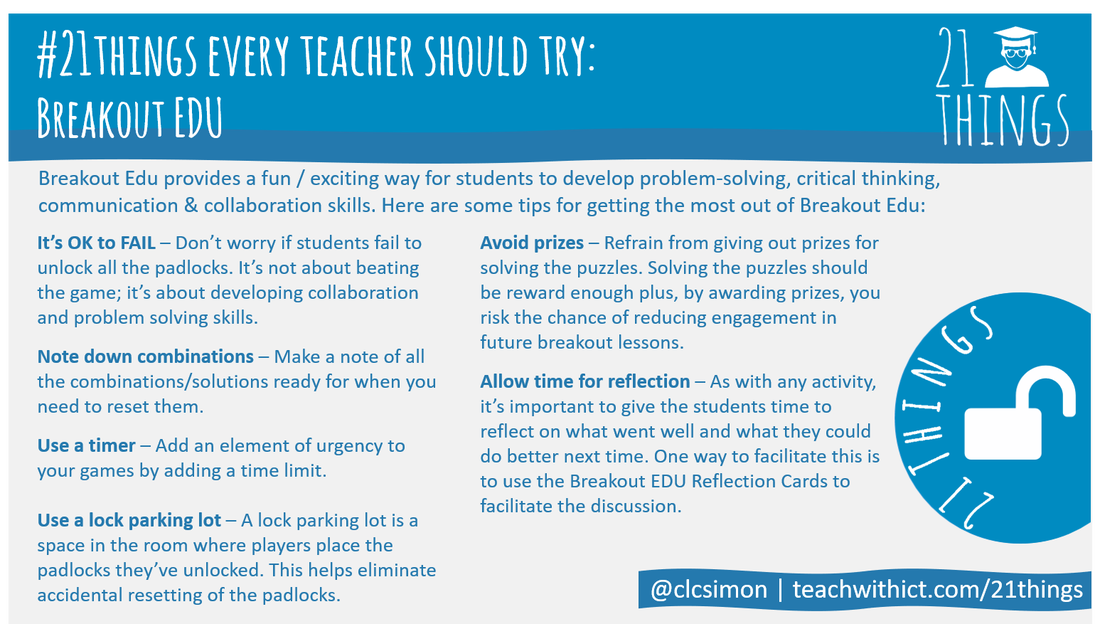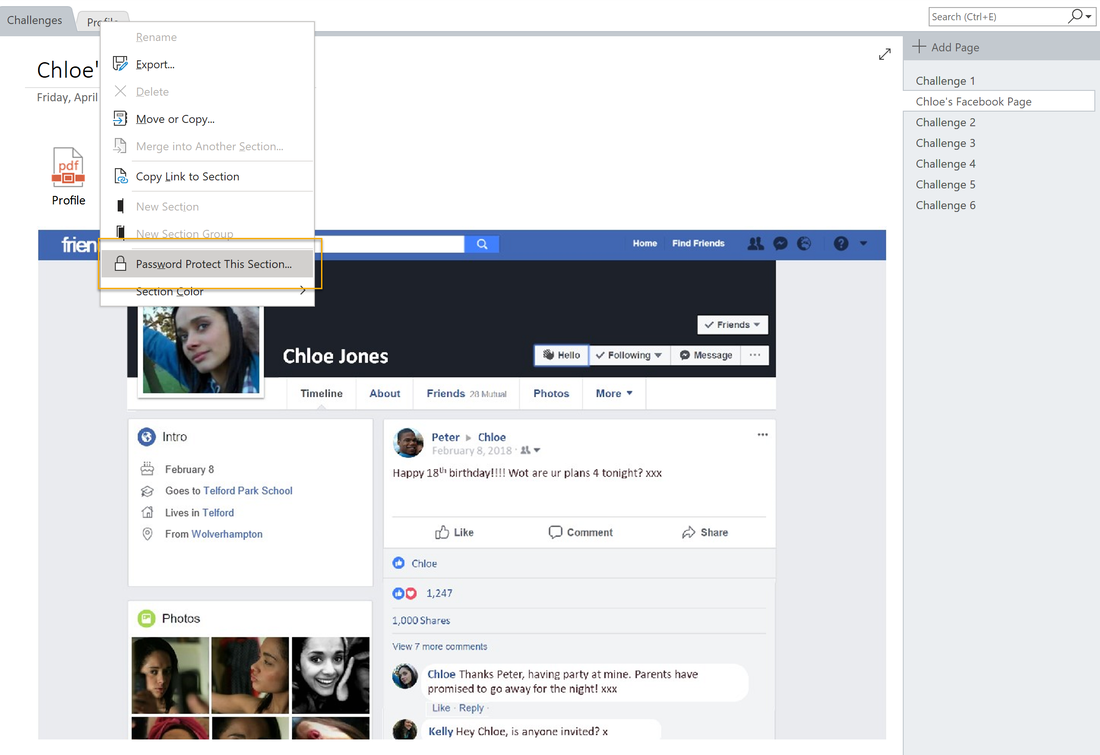21 things every teacher should try:
#BreakoutEdu
Reading Time: 3 minutes
Read further on down for tips on creating 'Virtual Escape Rooms' and free examples to download!
BreakoutEdu is an off-shoot of the popular ‘escape room’ game in which players are willingly locked in a room and, by searching for clues and completing a series of challenges, race against time to ‘break out’.
Welcome to Breakout Edu
Reasons to play Breakout Edu
Breakout EDU offers students a fun and exciting way to develop problem-solving, critical thinking, logical thinking, communication and collaboration skills.
Breakout EDU can be used to introduce a new topic or used to reinforce learning.
Breakout EDU offers students a fun and exciting way to develop problem-solving, critical thinking, logical thinking, communication and collaboration skills.
Breakout EDU can be used to introduce a new topic or used to reinforce learning.
Image used with permission. Image credit: @sylviaduckwoth / @MariaGalanis
Where to start
Breakout EDU kit
The official Breakout EDU kit (https://store.breakoutedu.com/) includes everything you need to play over 250 games created for the classroom environment. All the games are password protected so students can’t find the answers online. The kit costs $125.00 USD (£97 GBP). - Price correct as of August 2017. Price does not include tax and shipping.
On a tight budget?
For those on a tight budget or outside of the US, here is a list of alternatives for creating your own (DIY) BreakoutEdu kit:
Alternatively, if you already have a suitable box/case but no way of attaching a lock, you could wrap a bike chain around the box and use that to attach your padlocks.
Breakout EDU kit
The official Breakout EDU kit (https://store.breakoutedu.com/) includes everything you need to play over 250 games created for the classroom environment. All the games are password protected so students can’t find the answers online. The kit costs $125.00 USD (£97 GBP). - Price correct as of August 2017. Price does not include tax and shipping.
On a tight budget?
For those on a tight budget or outside of the US, here is a list of alternatives for creating your own (DIY) BreakoutEdu kit:
- Multi-lock hasp / Amazon Link
- 5 letter combo lock / Amazon Link
- 4 digit combo / Amazon Link
- 3 digit combo / Amazon Link
- Directional lock / Amazon Link
- UV Torch / Amazon Link
- UV Marker / Amazon Link
- Padlock with key / Amazon Link
- Tool box with hasp lock / Amazon Link
Alternatively, if you already have a suitable box/case but no way of attaching a lock, you could wrap a bike chain around the box and use that to attach your padlocks.
Tips:
For mire tips, visit: https://www.breakoutedu.com/blog/2016/12/22/5-tips-for-designing-your-first-game
- It’s OK to FAIL - Don’t worry if students fail to unlock all the padlocks. It’s not about beating the game; it’s about developing collaboration and problem solving skills.
- Use hint cards
- Note down combinations - Make a note of all the combinations/solutions ready for when you need to reset them.
- Use a timer - Add an element of urgency to your games by adding a time limit.
- Use a lock parking lot - A lock parking lot is a space in the room where players place the padlocks they’ve unlocked. This helps eliminate accidental resetting of the padlocks. See: https://www.breakoutedu.com/lock-tutorials-tips/
- Avoid prizes – Refrain from giving out prizes for solving the puzzles. Solving the puzzles should be reward enough plus, by awarding prizes, you risk the chance of reducing engagement in future breakout lessons.
- Allow time for reflection – As with any lesson, it’s important to give the students time to reflect on what went well and what they could do better next time. One way to facilitate this is to use the Breakout EDU Reflection Cards to facilitate the discussion.
For mire tips, visit: https://www.breakoutedu.com/blog/2016/12/22/5-tips-for-designing-your-first-game
Links:
- Tips for creating your first game: https://www.breakoutedu.com/blog/2016/12/22/5-tips-for-designing-your-first-game
- BreakoutEdu lessons: https://games.breakoutedu.com/
Virtual Escape Rooms
Traditionally, Breakout games require students to solve clues in order to open physical padlocks. However, if you don't want to go down the route of purchasing numerous locks, there are a number of 'digital' alternatives such as password protecting files or pages, for example, in OneNote.
In the following example, students have to examine a 'FakeBook' profile in order to find clues to work out Chloe's password. The password will unlock her profile page (Password pretected section) which also contains the next challenge! As well as being fun and engaging, this challenge also raises awareness about the importance of privacy settings on social media platforms and the fact that most people will create passwords based on memorable words or numbers such as pet's name, date of birth etc., all of which can be found on most people's profile.
In the following example, students have to examine a 'FakeBook' profile in order to find clues to work out Chloe's password. The password will unlock her profile page (Password pretected section) which also contains the next challenge! As well as being fun and engaging, this challenge also raises awareness about the importance of privacy settings on social media platforms and the fact that most people will create passwords based on memorable words or numbers such as pet's name, date of birth etc., all of which can be found on most people's profile.
Create virtual escape rooms in OneNote by password protecting sections!
Examples
Numeracy Breakout
| breakout_challenge_v2.pptx |






